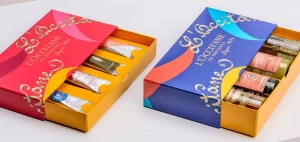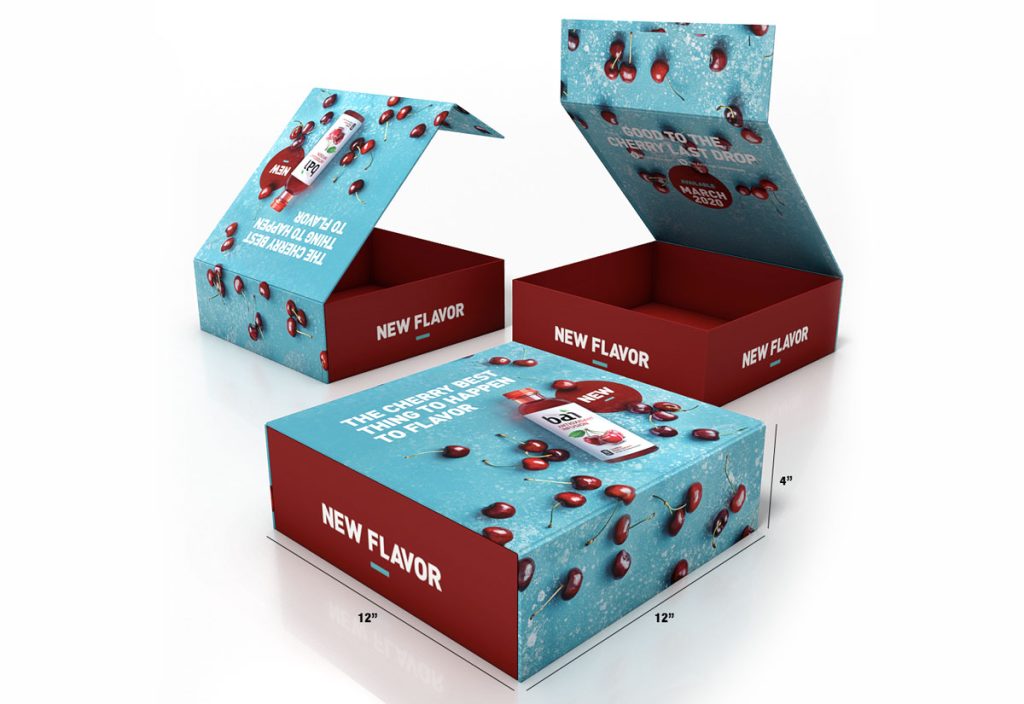A rigid packaging box is a popular option for certain products due to its support and luxury feel.
Because of its weight and expense, it is also known as premium packaging.
This article will describe rigid box packaging, its construction, disadvantages, advantages, and some successful examples.
Let’s begin!
What are Rigid Boxes?
The rigid boxes, made of resistant cardboard and often made of chipboard with a thickness of 2-3mm, are wrapped in the special finished paper.
These boxes are also premium packaging for gifts and retail products.
Rigid boxes are an excellent packaging option often used for premium packaging purposes.
In addition, rigid packaging gives your customers a luxury feel when unpacking and allows you to create a stronger brand story.
Many printing options are available for rigid boxes, including:
- Metallic Foil Stamping
- Spot UV
- Embossing/Debossing
Difference Between Flexible and Rigid Packaging
Looking at their names, it’s easy to see how rigid and flexible packaging differ.
Rigid packaging, made of thick cardboard, is a popular packaging segment. It refers to rigid packaging, which is different from its alternative, flexible packaging.
As the name suggests, rigid packaging will not change its shape. It’s more luxurious in look and feel and has a sturdy build and support.
It will last as long or protect as other packaging options like corrugated, and it will still give your products a sturdy construction.
The flexible packaging on the other side can be easily bent to take any shape you want.
Its primary distinguishing feature in this context is its versatility.
Flexible packaging, such as folding cartons, encompasses all packaging that can be easily bent. It is also available in several sizes.
To create luxury packaging solutions, rigid or set-up boxes are made of thick, durable cardboard.
In this case, we focus on rigid cardboard boxes.
Rigid packaging is a growing segment, but it’s a tiny one.
In 2015, the rigid paperboard market was worth USD 483.17 million. It continues to grow at an annual rate of 7.5%.
Rigid Box Types

There are two types of rigid boxes: partial finish and full finish.
Partial Finish Rigid Boxes
The partial finish is a type of rigid packaging where the packaging and chipboard are only a tiny part complete.
The wrapping is only used to cover the outer surface of the box. However, the chipboard inside is visible and unfinished.
Partially finished rigid boxes consist of a single chipboard piece with perforated fold lines. They are packed without an outer layer that exposes the gray chipboard or kraft material.
Due to the smaller material required in construction, partially finished rigid boxes take less time.
Final Finish Rigid Boxes
The rigid box is fully wrapped and sealed to ensure no chipboard is exposed.
Chipboards with a thickness of about 2-3mm are also available in thinner versions.
Depending on your needs, it can also be laminated with different finishing options.
A layer of packaging is added to rigid boxes with a full finish. It can be either white (default) or printed.
Styles for Rigid Packaging Boxes

Tube Box
Rigid tubes, also known as rolled edge packaging, are an eco-friendly option for anyone who wants to stand out.
Rigid tube packaging is a cylindrically shaped rigid package with no corners. It is often made with a telescopic opening or shoulder-neck style.
Box with Magnetic Closures
It can be strangely addictive to hear the satisfying click of a rigid magnetic closure box. The two magnets inside the boxes lock together to form a firm seal.
Two magnets are placed in rigid magnetic closure boxes to close the box.
These boxes are strong and durable, and customers won’t hesitate to take them out. This makes them a viable option.
Its unique structural engineering makes it possible to achieve a peak feel. Your customers will remember the magnetic closure for a seamless unpacking experience.
Boxes with magnetic closure are available in both standard and folding versions.
The standard style is stronger and lasts longer, but the rigid folding box with magnetic closure can be packed and shipped flat to reduce shipping and handling charges.
Double-sided tape is used to attach rigid collapsible boxes to their collapsible sides.
Your customers won’t be able to tell they’re foldable unless you examine them closely.
Telescopic
Telescopic or telescoping rigid boxes are also known as top-loading, 2-piece rigid containers, lid, and tray rigid packaging, with the lid dropping from the base vertically.
High-end telescopic boxes, such as smartphones, are designed with precise measurements that allow for friction and a slow opening speed so that the base can slide out from under the cover.
It’s an excellent choice for products used multiple times, making it a robust packaging option.
Partial lid rigid boxes, a telescoping box with a lid that only covers part of the base, are easier to open and close.
Drawer-Style Boxes (Tray and Sleeve)
They open the same way as matchboxes; drawer-style rigid boxes may also be called rigid, sliding, or tray and sleeve boxes.
Rigid drawer-style boxes can be attached with a pull tab or thumb hole. They are similar to rigid telescopic boxes but at a different angle.
Telescopic boxes are ideal for products you need to keep straight and level so customers can open the box.
It is better to open horizontally than vertically. This can help prevent accidents or even disasters.
You can make drawer-style boxes with built-in mechanisms to ensure children can’t open potentially dangerous products.
Book Style
Because it opens like a book, the book-style rigid box is an innovative packaging option.
You can do it with a straight or rounded spine to feel like a book. Magnetic attachments can also fit into this rigid packaging style.
This packaging style is unique but can add value to your brand identity depending on your niche.
Shoulder-Neck
This rigid box has several layers; it may have a shoulder or an inner cutting layer. Then a lid can be put on top.
This packaging is great if you want to have an unforgettable experience with your customers.
Once you’ve chosen the type of rigid packaging you prefer, think about the inserts that will be included.
Designers will often leave the neck of the shoulder-neck rigid box partially exposed to create the illusion of multiple layers or packaging. This can give customers the feeling that the product is state-of-the-art.
Essential Additional Packaging Materials
Additional packaging materials, such as box inserts, are essential when designing rigid packaging.
Packaging inserts are highly recommended if you want the best possible unboxing experience with a box.
A packaging insert is custom-made to fit your product. It helps it stay in place and provides a professional look.
These can be found in product boxes where the products fit perfectly in a rigid box.
Most commonly, custom inserts are in.
- Foam
- Cardboard
- Corrugated
- Plastic
Rigid Box Production
Rigid boxes are unlike any other packaging design. Rigid box production is similar to gift wrapping; they are made from precision-wrapped paper and solid boards.
These boards are usually available in a gray or kraft base color. However, they can also be made from partially recycled fibers.
Each chipboard is individually glued together to make your box rigid.
Rigid box production can be lengthy and take up to 2-3 weeks.
Most rigid box manufacturing processes require manual assembly. Quality checks are carried out in more detail to ensure no defects.
These rigid boxes are also more expensive than other types of packaging.
Rigid box packaging is a state-of-the-art packaging option. The luxury retail sector is a big fan of rigid boxes, which cost up to three times more than other paper product packaging options such as corrugated and cardboard boxes.
Many brands can justify a higher price because luxury packaging can increase the perceived value of the brand and the product.
Benefits
Rigid packaging is not only strong and protective but also has a luxurious, robust and unique appearance that is unmatched by other types of packaging.
Rigid packaging is often paired with a custom insert to protect products from rough handling.
Rigid packaging is designed to be reused and kept by customers, not thrown away when they are done using their product.
These benefits are why rigid boxes add significant value to your brand by creating an embedded element that matches your product.
It’s human nature to love gifts; rigid gift boxes are the current gold standard for packaging.
A rigid, branded gift box can be a great way to increase your product’s ROI.
Disadvantages
Although rigid boxes can be an excellent choice for small and medium-sized products, they are less durable for larger sizes.
Although rigid box packaging is excellent for small and medium-sized products, they are more susceptible to wear and tear at larger sizes due to the increased stress on their outer layers.
To increase the durability of larger sizes, it is always recommended to use thicker papers with a laminated finish.






Comments are closed for this post.